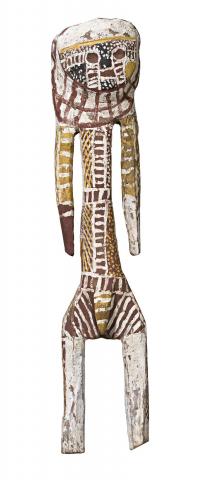PURUKAPALI, c.1955
Enraeld Djulabinyana Munkara
natural earth pigments and natural binders on carved ironwood
60.0 cm height
Acquired in Perth, 1970s
Private collection, Queensland
Purukapali and Bima c1955, collection of the National Gallery of Australia, in Caruana, W., Aboriginal Art, Thames and Hudson, London, 2003, p. 90, pl. 73 (illus.)
The Grief of Bima, c1965, collection of the Art Gallery of Western Australia, in O'Ferrell, M.A., Keepers of the Secrets; Aboriginal Art from the collection of the Art Gallery of Western Australia, Art Gallery of Western Australia, Perth, 1990, p.32 pl.27 (illus.)
The Artist in Pukumani for his Brother c1960, collection of the National Museum of Australia, in Luthi, B., et al. Aratjara: Art of the First Australians, Dumont, Cologne 1993 p.158 (illus.)
Enraeld Djulabinyana Munkara was one of the most distinguished sculptors among the Tiwi, a people renowned for their carving. Residing at Milikapiti (Snake Bay), Djulabinyana belonged to a group of artists on Melville Island in the 1950s and 1960s whose work was less subjected to Missionary influence. This figure of the Tiwi ancestor Purukapali bears all the hallmarks of his style. Charaterised by arms extending directly from the bulbous head, and legs running straight down from well defined hips, there is a distinct negative space between the legs. This void references those typical of Pukamani grave posts. Unlike other carvings by the artist, this figure has no sculptured base indicating it may have had a ceremonial function.
